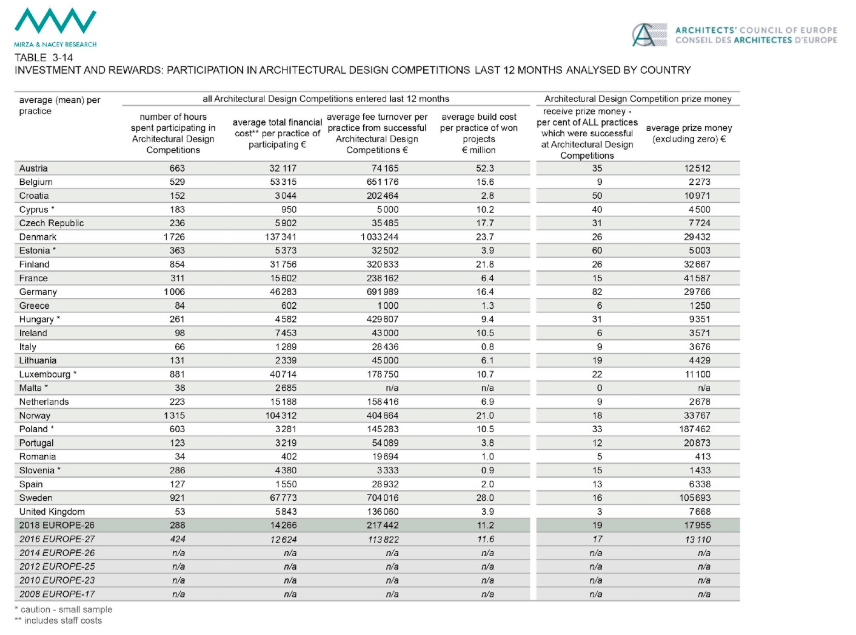The Architectural Profession in Central and Eastern Europe- 2018, Sector Study
After the 2018 Sector Study of the Architects’ Council of Europe
Overview
The EU institutions classify Architects as being part of business services or the construction sector, but our interests differ from those of industry; we are working for the quality of the built environment, for architectural quality and for a better life for the people using it. And this is reflected in the structure of the profession. We are not an industry, or even part of it; we are, by huge majority, small or even micro enterprises. This is clearly shown by this Sector Study in the structure of the profession. 71% of practices are one person practices, 25% are 2-5 people, 3% are 6-10. The legal form shows a slightly different picture. Looking at the last two studies 50 to 60% are working as independent architects, 7 to 10% in partnerships, and 20 to 30% have established a limited company.
On the other hand we see that the income of architectural practices is of moderate scale, and these factors show, that the huge majority of architects are not motivated by income, money and business, but are committed people, having in mind the quality, and let’s say, the beauty of what they are doing: the design and the appearance of the built environment.’
(Georg Pendl, ACE President, in the Foreword of the 2018 Sector Study)
There are fewer architectural practices in Europe than in previous years. The number of private practices in EUROPE is estimated to be 134 000 and grossing this figure up to reflect all 31 European countries produces an estimate of 140 000 private architectural practices in Europe. This year’s decline in the number of practices reflects a shift of the profession’s employment away from one or two person practices towards medium and large ones.
It is a cyclical move; as the profession moves into a more positive economic climate, many of the architects who established one or two person practices during the economic crisis either grown their practices or moved into larger practices. There are estimated to be substantially fewer practices in Denmark, Finland, Germany and Italy compared with the previous survey in 2016.
Well over half of architectural practices consider themselves to be “independent architects”, working on their own. This is the main form of architectural business in many countries; more than 80 percent of practices in Italy and Greece are ‘independent architects’, and more than 60 per cent in Germany, Malta and Spain. The next most popular legal formation of a practice is a Limited Company, accounting for 20 per cent of all practices across Europe but more than 50 per cent of practices in Croatia, Hungary, Poland and Romania.
Public Bids and Architectural Design Competitions
Fewer practices participated in an Architectural Design Competition in 2018; 12 per cent, compared with 20 per cent in 2016. But maybe as a consequence, the success rate was 43 per cent, rising to 58 per cent for private sector competitions. The highest level of participation in competitions is in Austria, Estonia, Luxembourg, France and Czech Republic.
Practices made, on average, 2.3 bids for projects advertised in the OJEU (Official Journal of the European Union), during the past year. The figure was substantially higher for practices in the Netherlands and Belgium. In response to a new question for 2018, 78 per cent of architects said that they had experienced difficulties as part of the bidding process for OJEU advertised projects. About 40 per cent of these respondents reported they had a difficulty in fulfilling the minimum turnover threshold; while nearly as many felt the process was too onerous. More than 30 per cent thought the bidding process was too costly, or that they had insufficient past experience.
On average, practices spent 288 hours in 2018 preparing for architectural design competitions. Total expenditure, including staff time preparing these bids, was very similar to the competition prize money received for successful bids. The total fees (excluding prize money) received for work on successful projects was 15 times the amount practices spent preparing these bids.
In the countries where SHARE Forum is being held each year, the percentage of practices participating in Architectural Design Competitions varies from 5% in Greece to 15% in Slovenia. Other percentages are Romania 9%, Poland 11% and Hungary with 14% of practices participating in Architectural Design Competitions.

Studying, Working and Earnings
One in five architects has studied in another country, and one in twelve architects has worked in another country in the last 12 months. Nearly all of those studying in another country did so in another European country, although about half of these architects studied in a country outside Europe as well. In the last twelve months, 6 per cent of architects have worked in another country in Europe, and 2 per cent in a country outside Europe. Substantial numbers of architects have “seriously considered” working in another European country, and 10 per cent in a country outside Europe.
More than half of architects from Cyprus, Luxemburg, Norway and Greece have undertaken part of their education in another country. About half of the architects in Romania, Slovenia, Malta and Greece have worked, or seriously considered working, in another country in the last year.
This survey from 2018 shows that Architects’ earnings continue to recover from the economic crisis although earnings are still not as high as they were in 2008. The average of all architects’ earnings is €32 700 (adjusted for PPP). This is 2 per cent higher than the 2016 survey figure, continuing a gradual upward trend which started after 2014. The headline rise is tempered by the finding that average earnings have barely changed, or even gone down, in several countries. In two countries, Poland and Greece, average earnings have trended down over the last ten years and are lower now than in any of the previous surveys.
Architects’ average earnings rise in line with the age increasing consistently between each five year age group to age 55-59, the peak earnings age. Architects aged under 30 earn significantly less than any other group; the average earnings of architects aged 35-39 are double those of architects aged under 30. In all cases, figures quoted are based on data which has been adjusted for PPP.
As far male and female earnings are concerned, they follow a very similar trend, and the differential has ranged between 25 and 32 per cent in favour of male architects. The pay gap is considerably smaller for part-time earnings, having fallen from 1 per cent in favour of males in 2016, to 2 per cent in 2018. Analysed by country, the gender pay gap is widest in Belgium, Romania and Luxembourg. In Croatia and the Czech Republic, average female earnings are slightly higher than male earnings. In general, the gender pay gap increases with age; in age 30 to 34 the gap is negative, meaning that female earnings are slightly higher than male earnings.
Analysis by country
The SHARE FORUM brings together each year hundreds of practicing architects and contractors from Europe, Asia and the United States of America, becoming one of the essential networking platforms for the construction-related fields in Central and Eastern Europe. Its annual editions are a constant relevant presence in Albania, Bulgaria, FYROM, Greece, Hungary, Poland, Romania, Serbia and from 2019 in Latvia and Slovenia.
The following charts show the ACE Study of the countries in Central and Eastern Europe, where the SAHRE Forum is held each year. The exceptions are Albania, FYROM and Serbia which didn’t provided data for the 2018 Sector Study.










